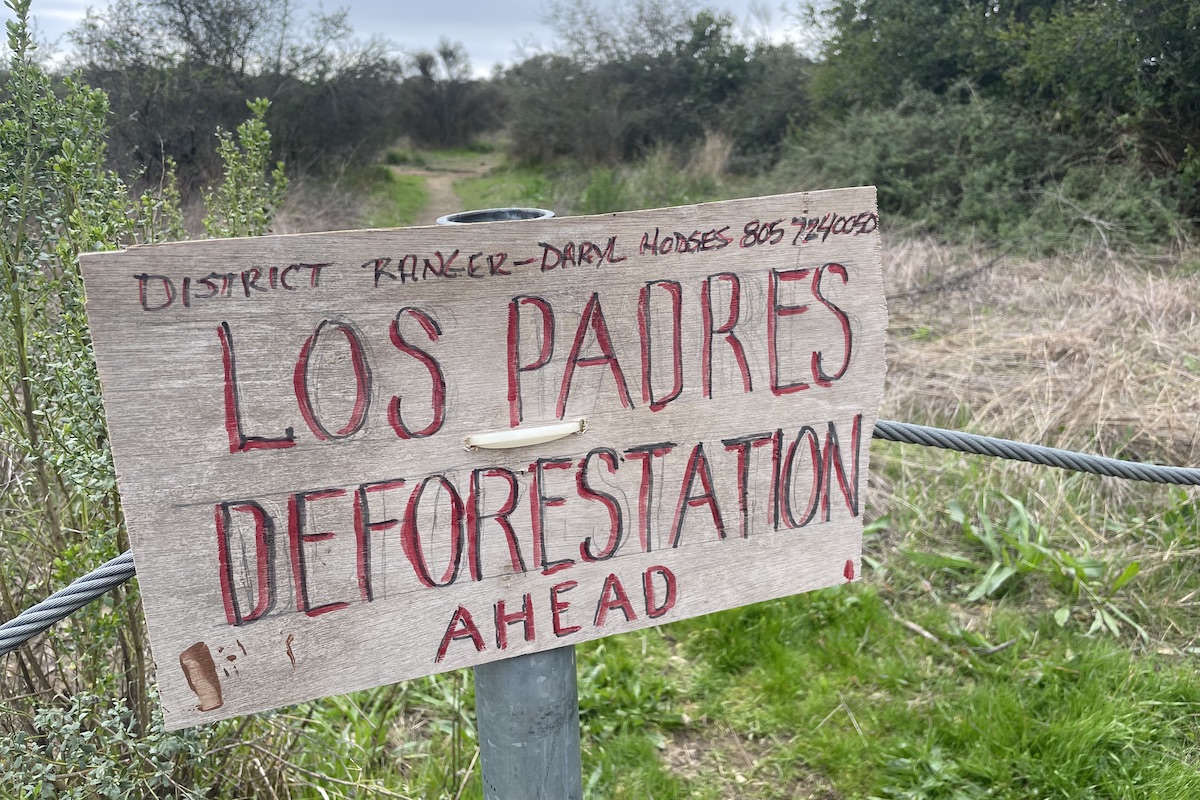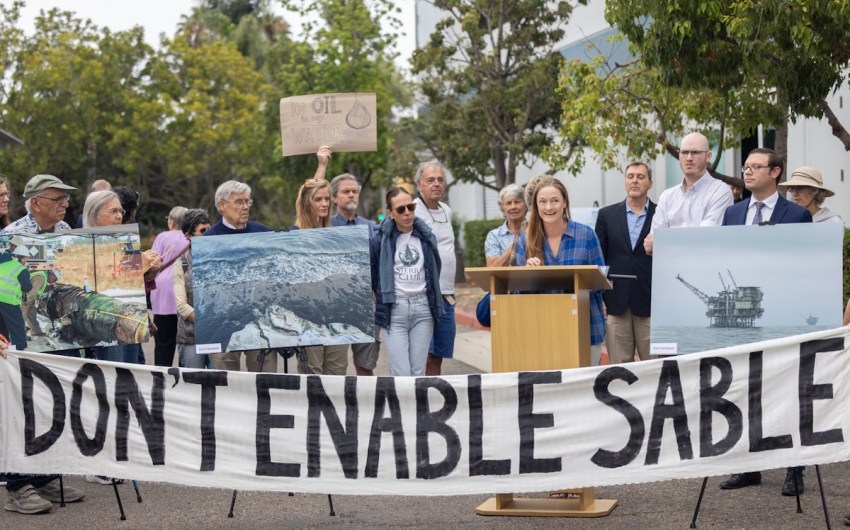Los Padres National Forest Service Continues Fuel-Reduction Work Along West Camino Cielo
Forest Service Says Work Will Safeguard Nearby Homes and Protect Wildlife and Natural Resources, but Some Residents View Project as Overkill

Tensions among mountain residents were reignited with the recent announcement of vegetation clearings across 200 acres of Camino Cielo, Painted Cave, San Marcos Trout Club, and Haney Tract communities — all in the name of fire defense.
The issue started with the mastication and removal of chaparral on the West Camino Cielo ridgeline overlooking Goleta Valley in November. Back then, a few angry neighbors yelled at a contractor and called out the Los Padres National Forest Service for what they saw as destruction of native habitat. Now, those same neighbors are again trying to block the Forest Service from finishing the job.
Forest Service contractors restarted vegetation-clearing work on August 19 and expect to complete the project in approximately one month’s time, depending on wildfires and other conditions.
According to the Forest Service, the project will create or expand on existing fuel breaks to reduce standing vegetation and mitigate any potential impacts of wildfire, safeguarding nearby mountain homes and protecting adjacent wildlife and natural resources.

However, some residents question the planning, oversight, and remediation processes involved. Danny Lewin, for one, sees the project as “irreversible destruction” of an old, “delicate ecosystem of chaparral” based on “random, reactive” decision-making. He views the plans as overkill, questioning their efficacy and alleging that they are rushed and based on analysis that is out-of-date. Others have called it outright “deforestation,” seeing as native chaparral, including manzanita and yucca trees, are some of the victims of mountainside clearings.
On the other hand, the Forest Service has spent decades maintaining fuel breaks across the Santa Ynez Mountain Range. The fuel-reduction work encompassing Camino Cielo and other communities is part of the “Santa Barbara Mountain Communities Defense Zone” project, for which public scoping was completed in 2017. These fuel breaks are meant to give firefighters some ground to stand on amid the next big blaze.
“This project has been well-documented and going on for a while,” said Seth Mitchell, deputy forest fire management officer. “It’s just the continuation of a community defense project. Obviously, some community members are supportive and some are not. But if we didn’t have overwhelming support then we’d probably reconsider.”
At a community meeting in February, District Ranger Daryl Hodges apologized for the lack of communication around the project’s implementation on the West Camino Cielo ridgeline.
He said that while “it’s gonna look messy in the beginning,” there are planned environmental mitigation efforts in place — including addressing “inevitable” invasive weeds and identifying and planting natives with higher tolerance to fire — and with time the land will start to heal. He also said that for all work going forward, they will be using hand crews and prescribed fire rather than mastication, based on community feedback.
“Yes, there is an ecological tradeoff, but the truth is the 1,000 acres included in the Santa Barbara Mountain Community Defense Zone and Camino Cielo Fuel Defense Zone Projects pales in comparison with the more than 281,000 acres that the Thomas Fire burned,” Hodges wrote to the Independent in March. “As we said several times during the community meeting: it’s a chance or a choice.”
While a select group of chaparral-loving Camino Cielo residents want to put a wrench in the Forest Service’s plans, others support the fire-mitigation efforts that “homeowners have wanted and been waiting for for 15 years,” in the words of Kenna Hickman, a member of the Camino Cielo Firesafe Community and a West Camino Cielo resident since 1985.


[Click to enlarge] Left: The more recently approved fuel breaks making up the “Santa Barbara Mountain Communities Defense Zone” add to the pre-existing fuel breaks stretching 40 miles across Camino Cielo. Right: Highlighted in red, the proposed fuel breaks, including West Camino Cielo, cover a combined 411 acres. | Credit: Courtesy
She called the Camino Cielo ridgeline a “high-risk area” of the mountain, comparing it to a fire “funnel.” She said that she was disappointed with how the Forest Service was treated when they first tried to implement the project in November, saying the handful of neighbors in opposition just have the “loudest” voices.
Both protestors and supporters of the fuel breaks say they want to protect their community, in one way or another. Hickman and other residents told the Independent that these fuel treatments are important for fire safety and firefighter protection, emphasizing that the destruction caused by out-of-control wildfires and harmful smoke is much worse than a couple hundred acres of cleared brush. Hickman also stressed the high cost of paying for fire insurance.
“Some people haven’t experienced living through a wildfire in our area,” Hickman said. “We just don’t want to see the worst happen.”
Premier Events
Sat, Sep 14
9:00 AM
Santa Barbara
InterAct Meet + Greet
Sat, Sep 14
10:00 AM
Santa Barbara
InterAct Advanced Course Theater Auditions
Sat, Sep 14
6:00 PM
Carpinteria
Beau James Wilding Vinyl Release Party at brewLAB
Thu, Sep 12
4:00 PM
Santa Barbara
The Mary Jane McCord Planned Parenthood Book Sale
Thu, Sep 12
6:00 PM
Santa Barbara
Traveling Edgar Allan Poe Speakeasy Heads To S.B.
Thu, Sep 12
7:30 PM
Santa Barbara
The Toledo Show: The Erotic Ostrich
Thu, Sep 12
8:00 PM
Santa Barbara
An Evening with the American Diamond – Neil Diamond Tribute Band
Fri, Sep 13
2:30 PM
Santa Barbara
SCAPE Exhibit and Sale
Fri, Sep 13
7:30 PM
Santa Barbara
The Producing Unit Presents “The Father”
Sat, Sep 14
11:00 AM
Santa Barbara
SCAPE Exhibit and Sale
Sat, Sep 14
12:00 PM
Buellton
SYV Children’s Museum Fall Carnival
Sat, Sep 14
2:00 PM
Santa Barbara
2nd Annual Downtown Santa Barbara Brew Fest
Sun, Sep 15
4:00 PM
Santa Barbara
Green Film Series: Doctrine of Recovery
Sat, Sep 14 9:00 AM
Santa Barbara
InterAct Meet + Greet
Sat, Sep 14 10:00 AM
Santa Barbara
InterAct Advanced Course Theater Auditions
Sat, Sep 14 6:00 PM
Carpinteria
Beau James Wilding Vinyl Release Party at brewLAB
Thu, Sep 12 4:00 PM
Santa Barbara
The Mary Jane McCord Planned Parenthood Book Sale
Thu, Sep 12 6:00 PM
Santa Barbara
Traveling Edgar Allan Poe Speakeasy Heads To S.B.
Thu, Sep 12 7:30 PM
Santa Barbara
The Toledo Show: The Erotic Ostrich
Thu, Sep 12 8:00 PM
Santa Barbara
An Evening with the American Diamond – Neil Diamond Tribute Band
Fri, Sep 13 2:30 PM
Santa Barbara
SCAPE Exhibit and Sale
Fri, Sep 13 7:30 PM
Santa Barbara
The Producing Unit Presents “The Father”
Sat, Sep 14 11:00 AM
Santa Barbara
SCAPE Exhibit and Sale
Sat, Sep 14 12:00 PM
Buellton
SYV Children’s Museum Fall Carnival
Sat, Sep 14 2:00 PM
Santa Barbara
2nd Annual Downtown Santa Barbara Brew Fest
Sun, Sep 15 4:00 PM
Santa Barbara
























You must be logged in to post a comment.